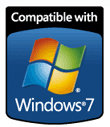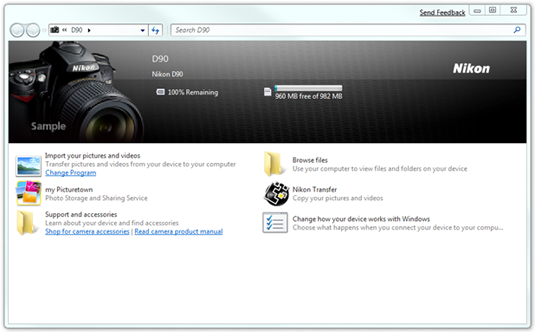Device Stage Gets Short Shrift
By Harry McCracken | Wednesday, September 30, 2009 at 9:26 am
 Microsoft blogged today about the compatibility logo program for hardware and software devices that will work with Windows 7. It’s in sync with Windows 7’s overall spirit of simplicity: There’s just one logo (“Compatible with Windows 7”) vs. the two that Microsoft came up with for Windows Vista. (“Works with Windows Vista” indicated basic compatibility; “Certified for Windows Vista” was more rigorous.)
Microsoft blogged today about the compatibility logo program for hardware and software devices that will work with Windows 7. It’s in sync with Windows 7’s overall spirit of simplicity: There’s just one logo (“Compatible with Windows 7”) vs. the two that Microsoft came up with for Windows Vista. (“Works with Windows Vista” indicated basic compatibility; “Certified for Windows Vista” was more rigorous.)
Simplicity is good–especially since nobody who doesn’t work at Microsoft and who isn’t involved in manufacturing hardware or developing software really knows the specifics of what the logo indicates. As the “Compatible” in “Compatible with Windows Vista” indicates, the emphasis this time around seems to be on ensuring that products will function reliably with all versions of the OS, including the 64-bit ones. It’s not claiming that a product is a shining example-the equivalent Windows XP logo had the loftier-sounding name of”Designed for Windows XP”–but just that it works.
But I’m sorry that Microsoft didn’t institute one additional requirement for hardware products: mandating that they support Device Stage, the OS’s new system for putting a bunch of features related to a peripheral in one place, such as a camera’s charge level, storage capacity, and tools for importing and transferring photos.

Device Stage is a good idea, but it’s a good idea that requires a fair amount of heavy lifting by hardware manufacturers, who need to put together the items for a particular product’s Device Stage. And it won’t be terribly useful unless you have a fair amount of confidence that the majority of your gadgets–the newish ones, at least–have Device Stages.
Weirdly, even though Windows 7 has been released to manufacturing, it’s too early to form an opinion about how well Device Stage is going to work out of the gate. When I worked on this long review of the new OS for PC World, I spent a fair amount of time plugging random gadgets into a Windows 7 PC. Most of them provided, at best, a sort of incomplete Device Stage that was only marginally useful. (Including a Nikon D90, a camera which Microsoft has touted as providing “great” Windows 7 support–I didn’t get most of the items shown in the above screen image, which was prepared by Microsoft.)
Eventually, a Microsoft representative told me what was going on: As hardware companies prepped themselves for Windows 7’s October 22nd release date, all Device Stages had been temporarily disabled, including the ones that had worked in earlier pre-release builds of Windows 7. In theory, the feature should work a heck of a lot better starting on the 22nd; I plan to plug a bunch of gizmos in on or around that date and see what happens.
But even if my experience improves a lot, I’m concerned that it won’t live up to its potential because too few companies will get their act together and build really good Device Stages. The Compatible with Windows 7 logo program could have provided Microsoft with an opportunity to prod companies into providing Device Stages. But the logo won’t tell you anything about whether a specific product has a Device Stage; providing one is an optional “Additional Qualification.”
I cheerfully accept the possibility that I’m being overly pessimistic that Device Stages will in fact became pretty pervasive pretty quickly. But for now, I’m sorry that Microsoft didn’t make the Windows 7 logo requirements at least a tad more demanding.
2 Comments
Read more:













September 30th, 2009 at 10:07 am
If companies find that implementing Device Stage for gadgets reduces their support costs, it will catch on at least for new(ish) things. If not, many won’t bother.
September 30th, 2009 at 3:19 pm
If Device Stage means companies don’t have to bother with their own in-house software then it will get used. But while most people are still using XP, the need for custom “bloatware” as I like to call it (software to sell me new ink etc) will still be needed. Nice to some positive Windows comments here also :o)